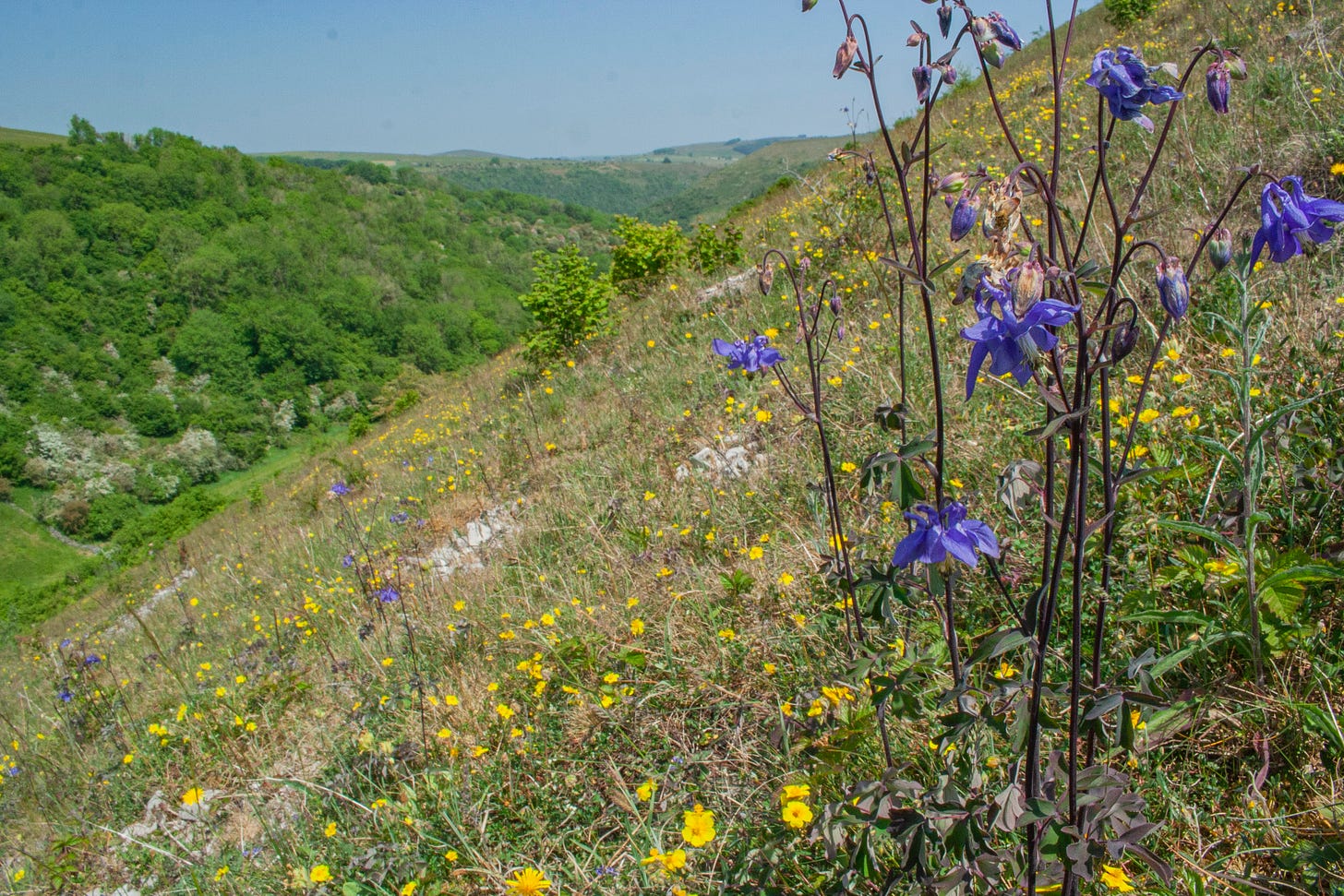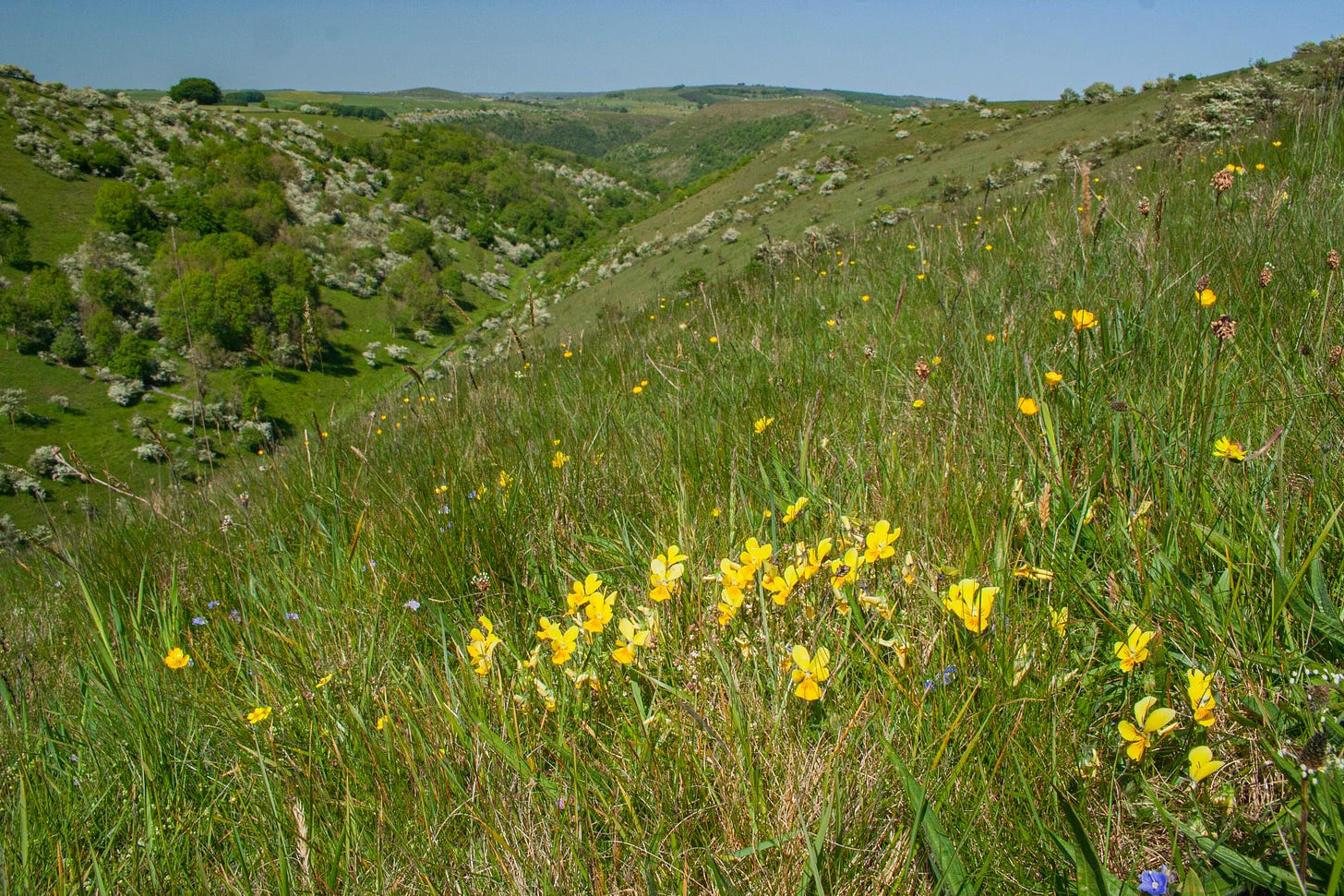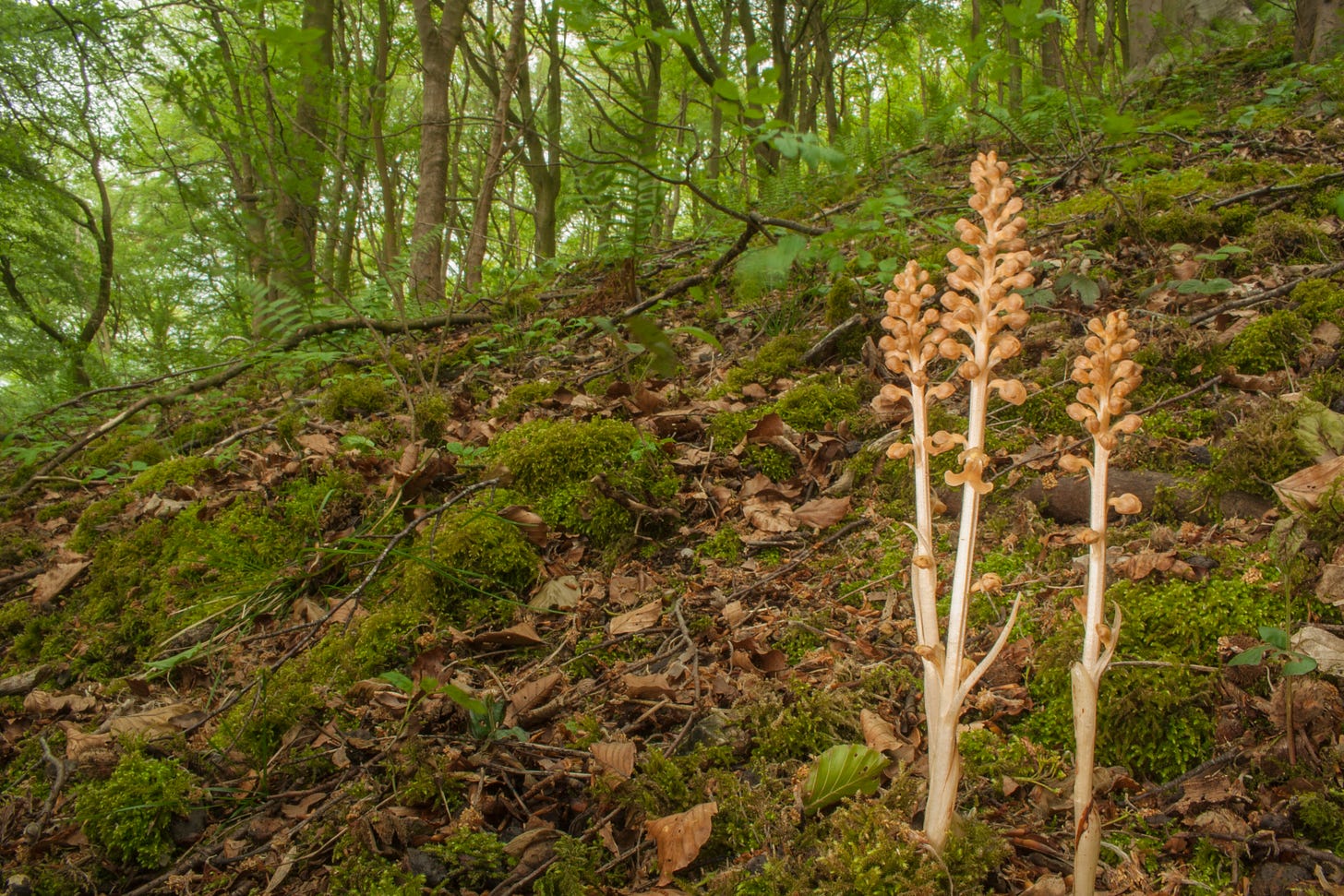Floral Frolics Down The Derbyshire Dales: Deep Dale (the one near Taddington Wood)
Deep Dale has a fraternal twin with which it shares several characteristics (see Floral Frolics Down The Derbyshire Dales: Deep Dale (the one near Topley Pike)). One of those characteristics is the virtue of its flora, a virtue so esteemed that it now benefits from the protection of a botanical conservation charity that boasts no less a status of international repute. That charity is Plantlife. Could those virtues be the aquilegia - blue and white, the yellow mountain pansy, lily-of-the-valley, leadwort, bilberry, false oxslip, the cowslips in their tens of thousands, or perhaps one of the rarest orchids in the county ? This humble list is just a summary of the diverse assemblage proliferating the sunny flanks of the dale. Notwithstanding are the habitats of grasslands - on alkaline and acid soils, hazel scrub, deciduous woodlands, cliffs and crags, disused mineral deposits, and a winterbourne stream; plus features like a magically ambient miniature gorge, and a prehistoric rock shelter. No wonder why Plantlife made it a nature reserve !
The officially recommended starting point to seek acquaintance with the dale is the White Lodge pay-and-display car park and picnic area located on the left-hand side of the A6 approximately 3.5 miles (5.5 kms) from Bakewell WNW in the direction of Buxton. Perplexingly it is not signposted from the road, but it is the only parking amenity opposite the landmark of the great, gaping mouth of Monsal Dale, immediately prior to the meandering ascent of the dual carriageway of Taddington bypass. At the time of writing, the all day parking charge is £4.75. However, there is a cheaper and certainly less populous alternative via the back door. Having exited Bakewell on the A6, opposite the village of Ashford-in-the-Water, take the junction south-west, simply signposted ‘Sheldon’. Drive through the village. After three quarters of a mile there is a T-junction. Turn right - west-north-west. Continue for half a mile or so to find a lay-by on the left (Grid Ref: SK 157 685). Looking NNE across the lane from the very charitably capacious lay-by, about half a mile in the distance, the cleft of Deep Dale is instantly apparent, as is the junction of the adjoining bridlepath on the opposite kerb that signifies the beginning of our journey. Before proceeding it must be stated that sections of the route are moderately difficult to traverse, ergo, a reasonable degree of personal fitness is a prerequisite.
The strips of unloved wastes on either side of the bridleway have been designated as Road Verge Reserves, a protected status justified, it is presumed, by the presence of species uncommonly encountered like heather and bilberry and a healthy stand of melancholy thistle; in favourable seasons even the elegant large-flowered hemp nettle.
At the bottom of the bridleway follow the footpath on the right that descends through a couple of pastures to a latch gate, also on the right, marked by a stout, square post on which is written the words ‘Deep Dale Nature Reserve, Plantlife’. Once inside, ignore the public footpath, instead, above the nearby dewpond, scramble up to the mid-contours of the steep slope, all the while heading more or less due north-east. The bold, V-shaped profile of the valley soon reveals itself entire, from the dust on your boots to the distant horizon.
May to June is the optimum period to visit when the surface of the reserve transforms into a multi-hued patchwork of early purple and common spotted orchids, cowslips, wood anemone, dog violets, meadow saxifrage, rockrose, milkwort, and mouse-ear hawkweed. Interposed with the grasslands are nebulous thickets comprised of ash, hazel, hawthorn, sloe, elderberry, wild roses, and, unexpectedly, silver birch, a tree more representational of the gritstone moors. Their shadier areas support bluebell, lords and ladies, dog violets, and lily of the valley. Yellow mountain pansy is widespread on the less alkaline soils of the uppermost zone and on the cascade of mining spoil found further towards the north-eastern limits of the flank where it co-exists with token specimens of leadwort. Desultory pockets of bilberry and restharrow are also happenchanced on the calcifuguous, elevated ground.
Contiguous to the official public footpath along the valley floor are the west-facing flank’s lower zones populated by thyme, mouse-ear hawkweed, rockrose, limestone bedstraw, pignut, tufted vetch, milkwort, crosswort, cow parsley, common spotted orchids - often albino, and the butter-yellow bouquets of false oxslips, progenies of the cowslips to the east and primroses to the west. If visiting in June, the field on the right prior to entering the reserve is transformed into a dense, swaying throng of pignut, buttercup and cow parsley. And don’t worry if you’ve come late to the party, Deep Dale always saves a selection of deserts in July and August even if you’ve missed the main menu: harebell, hawkweeds, lady’s bedstraw, musk thistle and valerian, the gorgeously delicate grass of parnassus, devilsbit scabious and small scabious - the latter being extraordinarily numerous.
The history of how Deep Dale became a nature reserve is as fascinating as the wild flowers it protects. Andy Kearsey, Plantlife’s Nature Reserve Manager (North and East England) kindly recalled the events. ‘Plantlife purchased Deep Dale in 1999. Previous to this the reserve had been owned by a local farming family. At the time, a Plantlife member had made a donation to the charity in memory of their mother. The donation came with a stipulation that the money [was] used to buy a reserve in the Peak District. Through contacts Plantlife staff had at the time within English Nature, they were informed that Deep Dale - which has long been considered one of the most important floral sites in the Peak District - could be bought from the farmer who owned it. This was seen as a good opportunity to expand Plantlife’s reserve network and protect part of the Wye Valley SSSI and Derbyshire Dale’s SAC. Further funding for the purchase was provided through a member’s appeal and from a donation from Unilever, following their Timotei advertising campaign in the late 90’s’.
Returning to the present, there are several well-trodden livestock trails on which to explore the botanical attributes of the west-facing flank: lower, middle, and upper, and each one possesses its merits. Alas, all except the highest disappear abruptly together with the flank itself at its bull-nosed corner overlooking the Wye Valley. Deserving some meditation at this advantageous height is the divine aspect that instantly unfolds to embrace the confluences of Taddington Dale and Monsal Dale mantled head to foot in their bottle-green woods of ash and hazel; a lush and leafy panorama of life.

Taking utmost care scramble down the flank to the valley floor then follow the footpath around to the right through a sylvan arcade until arriving at a timber signpost. We will return to this intersection later, but first, choose the direction north, waymarked ‘White Lodge, Monsal Dale’. This route ushers the visitor to Dimmins Dale, Deep Dale’s geological atrium, whereupon the sublime, mystical chasm can be explored. Along the way a blend of rocky grasslands and woodland glades gives rise to a rich mix of springtime plants: rockrose, mouse ear hawkweed, greater stitchwort, germander speedwell, crosswort, early purple orchids, cow parsley, meadow saxifrage, wood forgetmenot, red campion, lords and ladies, and bugle. Meadow cranesbill is especially copious later in the summer. Between Dimmins Dale and White Lodge car park the public footpath passes-by a small parcel of sloping pasture. Ordinary enough, except that, during May it sprouts such a superabundant mass of dazzling white meadow saxifrage it might probably be seen from space !
The other botanical attribute of Deep Dale’s northern zone is of incontestible significance and is happenchanced to the east. To reach it we must return to the timber waymarker post and take the trail in the direction of ‘Ashford, Sheldon’. Proceed along the trail until meeting a small wooden gate and drystone wall separating the hazel scrub from a plantation of tall, mature trees, mainly beech and sycamore, known on the map as Great Shacklow Wood. When visiting this wood in June, the object of desire lies just inside. With sharp eyesight and a favourable season you may be lucky enough to find bird’s-nest orchids, redolent, not unfancifully, of petit honey-brown bottle brushes poking out of the earth. Pale and unprepossessing, bird’s-nest orchids are bereft of chlorophyll, the fundamental molecule of all green plants enabling them to obtain energy by absorbing sunlight. Bird’s-nest orchids are saprophytic meaning that they acquire their power by sucking the goodness out of mycorrhizal fungi. The little colony shares its beech tree habitat with another saprophytic plant called toothwort.
To return to the lay-by from whence we came simply follow directions for ‘Deep Dale, Monyash’ at the footpath junction and continue on the main trail up the centre of the valley. Keep in mind that what hides in plain sight along the way there is often sighted plainly in their hide on the way back !
The author expresses his gratitude to Andy Kearsey of Plantlife https://www.plantlife.org.uk for kindly providing a history of the reserve.













